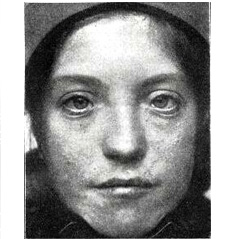







Typical appearence of person suffering from Waardenberg syndrome
Waardenburg syndrome (WS) is an inherited disorder often characterized by varying degrees of hearing loss and changes in skin and hair pigmentation. The syndrome got its name from a Dutch eye doctor named Petrus Johannes Waardenburg who first noticed that people with differently colored eyes often had a hearing impairment. He went on to study over a thousand individuals in deaf families and found that some of them had certain physical characteristics in common.
One commonly observed characteristic of Waardenburg syndrome is two differently colored eyes. One eye is usually brown and the other blue. Sometimes, one eye has two different colors. Other individuals with Waardenburg syndrome may have unusually brilliant blue eyes.
People with WS may also have distinctive hair coloring, such as a patch of white hair or premature gray hair as early as age 12. Other possible physical features include a wide space between the inner corners of eyes called a broad nasal root. In addition persons with WS may have low frontal hairline and their eyebrows may connect. The levels of hearing loss associated with the syndrome can vary from moderate to profound.
Individuals with Waardenburg syndrome may have some or all of the traits of the syndrome. For example, a person with WS may have a white forelock, a patch of white hair near the forehead, and no hearing impairment. Others may have white patches of skin and severe hearing impairment. The severity of the hearing impairment varies among individuals with WS as do changes in the skin and hair.
On rare occasions, WS has been associated with other conditions that are present at birth, such as intestinal disorders, elevation of the shoulder blade, and disorders of the spine. A facial abnormality, known as cleft lip and/or palate, also has been associated with WS.
Types of Waardenburg syndrome
There are at least four types of Waardenburg syndrome. The most common types of WS identified by scientists are Type 1 and Type 2. The different types of physical characteristics a person has determines the type of WS. Persons who have an unusually wide space between the inner corners of their eyes have WS Type 1. Hearing impairments occur in about 20 percent of individuals with this type of Waardenburg syndrome. Persons who do not have a wide space between the inner corners of their eyes, but who have many other WS characteristics are described as having WS Type 2. About 50% of persons with WS Type 2 have a hearing impairment or are deaf.
Cause
As a genetic disorder, Waardenburg syndrome is passed down from parent to child much like hair color, blood type, or other physical traits. A child receives genetic material from each parent. Because Waardenburg syndrome is a dominant condition, a child usually inherits the syndrome from just one parent who has the malfunctioning WS gene. Actually, there is a 50/50 chance that a child of an individual with WS will also have the syndrome.
Research studies
Scientists have identified and located four different genes for Waardenburg syndrome: PAX3, MITF, EDNRB, and EDN3. WS type 1 and 3 have been associated with mutations in the PAX3 gene; WS type 2 with the MITF gene; and WS type 4 with the EDNRB and EDN3 genes. While scientists are studying all of these genes, currently, the most information is available on the PAX3 and MITF genes and their role in Waardenburg syndrome.
The PAX3 gene is located on chromosome 2 and controls some aspects of the development of the face and inner ear. The MITF gene is found on chromosome 3. It also controls the development of the ear and hearing. Scientists are now studying these genes to better understand how they operate in controlling the normal growth of the ear and the development of hearing. This information will help scientists understand why persons with WS sometimes develop hearing problems.
>
>
>
>
>
>
>
>
>
>
>
>
>
>
>
>
>
>
>
>
>
>
>
>
>
>
INTRODUCTION
PIGMENTARY DISORDER TYPES
Disorders of
Hyperpigmentation
Disorders of Hypopigmentation
COMMON PIGMENTARY DISORDERS
Age Spots/Liver Spots/Lentigos
Acanthosis Nigricans
Albinism
Cafe-au-Lait Macules
Ephelides (Freckles)
Erythema Dyschromicum Perstans (Ashy Dermatosis)
Familial Racial Periorbital Hyperpigmentation
Idiopathic Guttate Hypomelanosis
Leopard Syndrome
Linea Nigra
Melanoma
Melasma
Nevus (birthmarks/moles)
Parkinsons Disease
Phytophotodermatits
Pityriasis Alba
Poikiloderma of Civatte
Postinflammatory
Hyperpigmentation & Hypopigmantation
Seborrheic Keratoses
Sturge-Weber Syndrome
Substance Induced
Hypermelanosis
Tinea Nigra/Tinea Versicolor/Pityriasis
Versicolor
Vitiligo
Waardenburg Syndrome

<< Previous: Vitiligo
Next: SKIN WHITENING AGENT TYPES >>